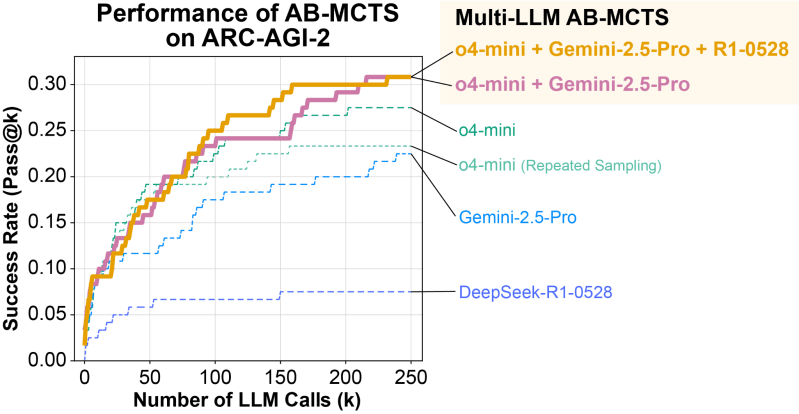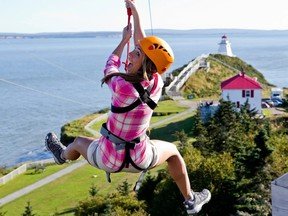Article content
Eight New Brunswick tourist attractions are joining the federal government’s offer of free or discounted admission this summer.

Want smarter insights in your inbox? Sign up for our weekly newsletters to get only what matters to enterprise AI, data, and security leaders. Subscribe Now
Japanese AI lab Sakana AI has introduced a new technique that allows multiple large language models (LLMs) to cooperate on a single task, effectively creating a “dream team” of AI agents. The method, called Multi-LLM AB-MCTS, enables models to perform trial-and-error and combine their unique strengths to solve problems that are too complex for any individual model.
For enterprises, this approach provides a means to develop more robust and capable AI systems. Instead of being locked into a single provider or model, businesses could dynamically leverage the best aspects of different frontier models, assigning the right AI for the right part of a task to achieve superior results.
Frontier AI models are evolving rapidly. However, each model has its own distinct strengths and weaknesses derived from its unique training data and architecture. One might excel at coding, while another excels at creative writing. Sakana AI’s researchers argue that these differences are not a bug, but a feature.
“We see these biases and varied aptitudes not as limitations, but as precious resources for creating collective intelligence,” the researchers state in their blog post. They believe that just as humanity’s greatest achievements come from diverse teams, AI systems can also achieve more by working together. “By pooling their intelligence, AI systems can solve problems that are insurmountable for any single model.”
Sakana AI’s new algorithm is an “inference-time scaling” technique (also referred to as “test-time scaling”), an area of research that has become very popular in the past year. While most of the focus in AI has been on “training-time scaling” (making models bigger and training them on larger datasets), inference-time scaling improves performance by allocating more computational resources after a model is already trained.
One common approach involves using reinforcement learning to prompt models to generate longer, more detailed chain-of-thought (CoT) sequences, as seen in popular models such as OpenAI o3 and DeepSeek-R1. Another, simpler method is repeated sampling, where the model is given the same prompt multiple times to generate a variety of potential solutions, similar to a brainstorming session. Sakana AI’s work combines and advances these ideas.
“Our framework offers a smarter, more strategic version of Best-of-N (aka repeated sampling),” Takuya Akiba, research scientist at Sakana AI and co-author of the paper, told VentureBeat. “It complements reasoning techniques like long CoT through RL. By dynamically selecting the search strategy and the appropriate LLM, this approach maximizes performance within a limited number of LLM calls, delivering better results on complex tasks.”
The core of the new method is an algorithm called Adaptive Branching Monte Carlo Tree Search (AB-MCTS). It enables an LLM to effectively perform trial-and-error by intelligently balancing two different search strategies: “searching deeper” and “searching wider.” Searching deeper involves taking a promising answer and repeatedly refining it, while searching wider means generating completely new solutions from scratch. AB-MCTS combines these approaches, allowing the system to improve a good idea but also to pivot and try something new if it hits a dead end or discovers another promising direction.
To accomplish this, the system uses Monte Carlo Tree Search (MCTS), a decision-making algorithm famously used by DeepMind’s AlphaGo. At each step, AB-MCTS uses probability models to decide whether it’s more strategic to refine an existing solution or generate a new one.
The researchers took this a step further with Multi-LLM AB-MCTS, which not only decides “what” to do (refine vs. generate) but also “which” LLM should do it. At the start of a task, the system doesn’t know which model is best suited for the problem. It begins by trying a balanced mix of available LLMs and, as it progresses, learns which models are more effective, allocating more of the workload to them over time.
The researchers tested their Multi-LLM AB-MCTS system on the ARC-AGI-2 benchmark. ARC (Abstraction and Reasoning Corpus) is designed to test a human-like ability to solve novel visual reasoning problems, making it notoriously difficult for AI.
The team used a combination of frontier models, including o4-mini, Gemini 2.5 Pro, and DeepSeek-R1.
The collective of models was able to find correct solutions for over 30% of the 120 test problems, a score that significantly outperformed any of the models working alone. The system demonstrated the ability to dynamically assign the best model for a given problem. On tasks where a clear path to a solution existed, the algorithm quickly identified the most effective LLM and used it more frequently.

More impressively, the team observed instances where the models solved problems that were previously impossible for any single one of them. In one case, a solution generated by the o4-mini model was incorrect. However, the system passed this flawed attempt to DeepSeek-R1 and Gemini-2.5 Pro, which were able to analyze the error, correct it, and ultimately produce the right answer.
“This demonstrates that Multi-LLM AB-MCTS can flexibly combine frontier models to solve previously unsolvable problems, pushing the limits of what is achievable by using LLMs as a collective intelligence,” the researchers write.

“In addition to the individual pros and cons of each model, the tendency to hallucinate can vary significantly among them,” Akiba said. “By creating an ensemble with a model that is less likely to hallucinate, it could be possible to achieve the best of both worlds: powerful logical capabilities and strong groundedness. Since hallucination is a major issue in a business context, this approach could be valuable for its mitigation.”
To help developers and businesses apply this technique, Sakana AI has released the underlying algorithm as an open-source framework called TreeQuest, available under an Apache 2.0 license (usable for commercial purposes). TreeQuest provides a flexible API, allowing users to implement Multi-LLM AB-MCTS for their own tasks with custom scoring and logic.
“While we are in the early stages of applying AB-MCTS to specific business-oriented problems, our research reveals significant potential in several areas,” Akiba said.
Beyond the ARC-AGI-2 benchmark, the team was able to successfully apply AB-MCTS to tasks like complex algorithmic coding and improving the accuracy of machine learning models.
“AB-MCTS could also be highly effective for problems that require iterative trial-and-error, such as optimizing performance metrics of existing software,” Akiba said. “For example, it could be used to automatically find ways to improve the response latency of a web service.”
The release of a practical, open-source tool could pave the way for a new class of more powerful and reliable enterprise AI applications.
Trusted News Since 1995
A service for travel industry professionals
·
Monday, July 21, 2025
·
832,504,696
Articles
·
3+ Million Readers
Shocking footage posted to the Instagram account TouronsOfYellowstone (@touronsofyellowstone) brought attention to the moment four bikers cut through the Grand Prismatic at Yellowstone National Park.
“The 4 of them were biking from the tree line towards the boardwalk when, as they were nearing the actual hot springs, several people yelled at them to turn around,” the caption reads.
The Grand Prismatic in Yellowstone is the largest hot spring in the United States, known for its geysers. Microbial mats have played a major role in scientific research and help preserve the unique geothermal ecosystem. Biking over the springs is not only dangerous for bikers, but it also has considerable impacts on the landscape.
“I have never seen anything like this in Yellowstone ever after many decades,” TouronsOfYellowstone wrote. “This is next level! I just don’t understand the thought process these people had to think that it was okay for them to not just walk but to ride their bikes on the Grand Prismatic.”
Infiltrating ecosystems meant to be preserved can lead to a slew of legal issues. Some people who have done so have ended up with $5,000 in fines. Risking safety is also a dangerous factor. Geysers such as the Grand Prismatic have been known to seriously injure or kill people who have broken safety protocols.
Brandon Gauthier, Yellowstone’s chief safety officer, explained that the park tries “to educate people starting when they come through the gate.” Gauthier further stated that there is “a fine line between giving visitors a chance to get close to popular attractions and ruining the natural landscapes that national parks were created to preserve.”
Due to past deaths, the park continues to emphasize how dangerous such actions can be.
Trespassing can further ruin biodiversity. Tourist interference has caused water pollution, introduced invasive species, and damaged microbial mats, according to some reports. Biking over the ecosystem is undoubtedly another massive blow to the preservation of the geysers.
Disregarding safety signs and regulations can also make wildlife interactions more likely, endangering both humans and animals. Animals that injure humans, whether they’re provoked or not, may be euthanized.
Commenters were appalled by the tourists’ behavior.
💡Upway makes it easy to find discounts of up to 60% on premium e-bike brands
“They should all be arrested immediately, fined and banned from all national parks forever,” voiced one angry user.
Another user commented, “I’ve said it before, the possibility of being boiled alive and turned into goo does not scare people enough.”
To avoid legal, safety, and biodiversity issues, the solution is clear: Follow the rules when enjoying national parks.
Join our free newsletter for good news and useful tips, and don’t miss this cool list of easy ways to help yourself while helping the planet.

A short list of staples selected by Ottawa now offer free admission for children aged 17 and under and 50 per cent off for those 18 to 24
Eight New Brunswick tourist attractions are joining the federal government’s offer of free or discounted admission this summer.
Advertisement 2
Article content
The Beaverbrook Art Gallery, Kings Landing Historical Settlement, Ministers Island, Cape Enrage, and Fort La Tour in Saint John are among a short list of cultural and historical staples in the province selected by Ottawa to offer free admission for children aged 17 and under and 50 per cent off admission fees for youth aged 18 to 24.
That’s with the feds saying they’re paying to offset admission costs.
Mark Carney ran on a federal election campaign promise to offer free or discounted admission to some of the country’s most iconic places through what he called a “Canada Strong Pass” with hopes to see more Canadians vacationing at home this summer.
The initial announcement included free admission for all visitors to national historic sites, national parks, and national marine conservation areas administered by Parks Canada and a 25 per cent discount on camping fees until Sept. 2.
Article content
Advertisement 3
Article content
VIA Rail travel is free for children aged 17 and under when accompanied by an adult with a 25 per cent discount for young adults aged 18 to 24.
National museums also have free admission for children 17 and under and a 50 per cent discount for 18 to 24.
The feds then suggested other attractions may join in.
It has now announced that 86 provincial and territorial museums and galleries will be participating.
In New Brunswick, there’s eight:
Advertisement 4
Article content
“Provincial and territorial museums and galleries were invited to join the Canada Strong Pass initiative, with government of Canada support helping offset admission costs,” the federal government said in a statement. “These museums are in addition to the national museums in Canada that are offering the same benefits.
“Now is the perfect time for Canadians to explore their rich cultural history and traditions by visiting and learning at any of these wonderful museums.”
In a statement, Beaverbrook Art Gallery spokesperson Curtis Richardson said Ottawa invited it to submit an application to the Canada Strong Pass Initiative under the Museums Assistance Program through Canadian Heritage.
“The funding they offer supports the costs associated with implementing the Canada Strong Pass, this includes help compensating for lost revenues,” Richardson said, believing the dollars will be enough to cover any loss.
Advertisement 5
Article content
He added that the gallery is “confident with our admission projections that we won’t incur any losses by being a part of this initiative.”
The feds confirmed that each eligible organization had to complete an application with information including their total admission revenues for the last completed fiscal year.
Funding of up to 15 per cent of total admission revenues for the last year is then provided, up to a maximum of $1 million.
The discounts are available until Sept. 2.
While the program is called the Canada Strong Pass, no registration or physical pass is actually necessary – just show up and enjoy the benefits offered at participating establishments, according to the feds.
The program is open to all visitors, whether you are Canadian or coming from abroad.
Advertisement 6
Article content
The discounts are also on top of one recently announced by the Holt government, which has discounted all provincial park passes for New Brunswickers by 25 per cent.
“We are doing this to help make vacationing in New Brunswick and staying in New Brunswick and getting outside in New Brunswick with your families more affordable,” Holt said at an announcement held at Fundy Trail Provincial Park in May.
The new Fundy Trail Provincial Park is one of the seven parks with discounted admission fees this season.
The six others are New River Beach, Murray Beach, Parlee Beach, Mount Carleton, Le Village Historique Acadien and Hopewell Rocks provincial parks.
Six other provincial parks don’t charge entrance fees.
More than 1.1 million visitors took in New Brunswick’s provincial parks in the 2024-25 fiscal year. Last year, New Brunswickers accounted for 235,000 paid daily visits.
Article content


Amazon weighs further investment in Anthropic to deepen AI alliance


How Elon Musk’s rogue Grok chatbot became a cautionary AI tale


Voice AI Startup ElevenLabs Plans to Add Hubs Around the World


Looking For Adventure In Asia? Here Are 7 Epic Destinations You Need To Experience At Least Once – Zee News


UK crime agency arrests 4 people over cyber attacks on retailers


‘Will AI take my job?’ A trip to a Beijing fortune-telling bar to see what lies ahead | China


EU pushes ahead with AI code of practice


ChatGPT — the last of the great romantics


CheQin.ai Redefines Hotel Booking with Zero-Commission Model


Humans must remain at the heart of the AI story